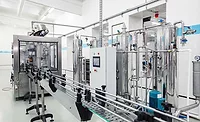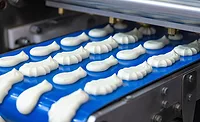Progress in the Hygienic Design of Food Processing Equipment
A few decades ago, it was difficult for food processors to obtain hygienic equipment because only a few companies built such equipment. Most manufacturers of equipment for the food industry maintained that their equipment was good, as they never received complaints from their customers. When I was with Unilever, we had a meeting with about 25 equipment manufacturers from all over Europe. I expressed my amazement at their consensus of opinion and told them that if they never heard complaints, they weren’t listening, because at Unilever, we heard complaints from many of our food companies. After many such discussions, the equipment manufacturers agreed to work with the food industry to improve equipment design. This was the start of the European Hygienic Engineering and Design Group (EHEDG),[1] now a successful organization in its 26th year.
The EHEDG today has sections in most European countries and, increasingly, in countries on other continents. The EHEDG produces guidelines that are intended to clarify how to avoid mistakes in the design of equipment that may lead to uncontrolled growth of microbes, leading to unacceptable risks of spoilage, food poisoning and even death. In addition, several books have been published with the same objective, providing more detail and references to the underlying research. Since then, hygienic design of food processing equipment has progressed enormously, and there is a large choice of hygienic equipment on the market, much of which has been EHEDG-certified.[2] If all of this information is available, why then does equipment still cause food poisoning incidents?
The issue apparently is that the availability of information differs from the application of information. Although there are many responsible companies that indeed try to apply this information, other companies find it too expensive and knowingly take risks, assuming that accidents happen elsewhere but not in their company. This reasoning still applies to equipment manufacturers that make designs that are cheaper to produce but present a hygiene risk. That might even be acceptable if they would admit this to the users of the equipment, who then could take this into account when deciding on cleaning regimes and frequencies. It does, however, also apply to some food processors that could buy hygienically good equipment but knowingly buy cheaper, less hygienic equipment.
In the EU, it is compulsory to use hygienic equipment in food handling. Governments also have a food safety responsibility here, because knowing that not every company complies with the law, there should be adequate inspections. When a food poisoning incident takes place and the investigation concludes that the equipment is the source of the incident, the equipment manufacturer often claims innocence, because it is not responsible for the correct operation of the equipment. The food company also claims innocence because it trusted that the equipment purchased met the legal requirements and hence was adequate. The food inspection authority cannot be made responsible because there is never the capacity to inspect everything everywhere. Hence, even when an incident has resulted in deaths of consumers, nobody is responsible, little is learned and another incident is right around the corner.
There is one essential requirement that applies to all three parties: The employees who are made responsible for the design of the equipment, for purchasing and operation of suitable equipment and those responsible for inspection should all have been trained appropriately. This, on the one hand, is a matter of proper education before actual employment and, on the other hand, continuous education on the job. This is a crucial point but it’s grossly underestimated in many situations.
Some Pertinent Examples
Meat processing:
When I visited a sausage processor to help find the source of a recurring contamination of the final product, I asked to dismantle a temperature probe in the process line. This was done after the cleaning-in-place of the process line and therefore reluctantly, because dismantling may contaminate the cleaned and disinfected line. To the amazement and shame of the company staff, the temperature probe, assumed to be of hygienic design and shiny in appearance (it certainly looked clean), had several crevices that were full of spoiled product residue. The line had recently been “approved” by an inspector of the local food safety authority. The inspector had not opened anything in the process line, and the company had trusted the supplier of the temperature probe (and other line components) that it was indeed hygienic and thus without crevices that could not be cleaned.
Dairy processing:
When I visited a dairy plant with a persistent contamination of the final product that occurred consistently within a few hours after the start of production, it appeared that several valves in the process line, when removed for inspection after cleaning-in-place and taken apart for a thorough inspection, smelled very bad. The reason appeared to be that milk had accumulated behind a membrane and was badly spoiled; shortly after the start of production, this spoiled milk residue began to release microbes, contaminating the final product. The valves had been selected from a catalog of a renowned equipment company as “aseptic” and were also expensive (meaning that the food company had no intention of taking risks by choosing cheaper designs). Replacing the valves by another type solved the problem.
Frozen novelty processing:
In an ice cream company, the final product regularly appeared not to be properly pasteurized, although the temperature had been correct every time—the temperature sensor had been inspected and calibrated several times. The residence time had been properly calculated, meaning that the number of plates on the plate heat exchanger (PHE) frame was correct. Moreover, at the beginning, when the plant was commissioned, everything looked fine and the microbiological test results were excellent.
To determine the cause of the problem—a variety of microbes surviving pasteurization—various components of the line had been taken out for inspection and looked clean after cleaning-in-place. After a few days, all components had been thoroughly inspected. Not, however, the PHE. The assumption was that the PHE could not be the problem, because it was the pasteurizer and it came from a reliable manufacturer with a long history of good designs. The cleaning procedure recommended by the producer was carefully followed: Every day, the cleaning was done twice before pasteurization was resumed. Moreover, it was assumed that taking apart the PHE would do more harm than good, because disassembly might damage the gaskets and plates, and it would take hours to reassemble the PHE. But insistence eventually works, and after cleaning (twice), the PHE was dismantled. To the embarrassment of the company’s staff and the representative of the PHE supplier, most of the plates proved to be extremely dirty, with brownish, sticky residue on the surfaces on the product side of the plates. It could easily be seen that as a consequence, the “free” volume between the plates was much less than would be the case if the plates had been clean. Thus, the effective volume of the holding section of the PHE was a fraction of the intended volume, and the holding time a fraction of what it was supposed to be. By manually cleaning the plates and thereafter changing the cleaning procedure so that it could cope with the product to be pasteurized, the problem was solved and did not reoccur.
Fish processing:
In the Netherlands in 2012, about 23,000 people became ill and 4 died as a result of eating salmon contaminated with Salmonella Thompson;[3] the cause appeared to be the presence and multiplication of Salmonella in the porous sides of supports made from polyvinyl chloride used to transport the salmon on a conveyor belt. The porous sides retained moisture (likely containing fish proteins), enabling microbes to multiply.[4] This was an oversight in the design that could have been avoided if the designer had understood the hazard, which has been discussed in many publications, such as Hygiene in Food Processing.[5] There are many more examples, such as an outbreak of listeriosis associated with Jensen Farms cantaloupes in the U.S. in 2011 and Salmonella Typhimurium infections associated with peanut products, also in 2011 (cited by Schmidt and Pierce[6]).
Preventing Food Safety Incidents: Education and Training
The staff of manufacturers of equipment for the food industry should have knowledge of hygienic design, meaning they should also have learned the basics of microbiology. Similarly, the staff of food companies should be aware of the microbiological problems that may be caused by wrongly designed or wrongly used equipment. They should have been trained in reading technical drawings. Food safety inspectors will have knowledge of microbiology, as often they are veterinarians. While their education often includes the “construction” of animals, it does not usually encompass the construction of equipment. Therefore, it cannot be expected that a food safety inspector can judge whether a food factory is hygienic or not and should not be given that task before he or she has been adequately trained. Hence, the education of safety assurance managers, engineers who design food processing equipment and veterinarians (or professionals with other backgrounds) who are appointed as food safety inspectors should include training before they are expected to carry out such responsibilities. In addition, we can learn from incidents, meaning it should be made compulsory to publish the results of the investigations of the causes of food safety incidents.
Finally, the design of equipment and process lines should be a joint activity of equipment manufacturers and food processors. Together, they should write the specifications and the operation procedures for the product that is to be made with the equipment. Only in this way can the industry reduce the frequency of equipment-related causes of foodborne illnesses.
Huub Lelieveld is president of the Global Harmonization Initiative and past president of the European Federation of Food Science and Technology. He is also the founder of the EHEDG and a member of the Editorial Advisory Board of Food Safety Magazine.
References
1. www.ehedg.org.
2. www.ehedg.org/?nr=82&lang=en.
3. www.eurosurveillance.org/ViewArticle.aspx?ArticleId=20303.
4. Postma, R. 2012. Salmonella in zalm by Foppen. NRC Handelsblad November 17.
5. Lelieveld, HLM, MA Mostert and GJ Curiel. 2000. Hygienic Equipment Design. In Hygiene in Food Processing. Eds. HLM Lelieveld, MA Mostert, J Holah and B White. Cambridge, UK: Woodhead Publishing, 151.
6. Schmidt, RH and PD Pierce. 2015. The Use of Standard Operating Procedures (SOPs). In Handbook of Hygiene Control in the Food Industry, 2nd ed., Cambridge, UK: Woodhead Publishing, in press.
Looking for quick answers on food safety topics?
Try Ask FSM, our new smart AI search tool.
Ask FSM →







